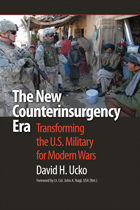War 2.0: Irregular Warfare in the Information Age

War 2.0: Irregular Warfare in the Information Age
By Thomas Rid and Marc Hecker
My copy just arrived and from a quick scan through the United States (Small Wars Journal discussed here as an example of a public community of practice and our new media discussion several months ago is cited) and United Kingdom chapters - looks very informative and interesting - I will have a detailed review later.
Book Description
The rise of insurgencies and the rise of the Web are two grassroots trends that are operating in tandem to put modern armies under huge pressure to adapt new forms of counterinsurgency to new forms of social war.
War 2.0: Irregular Warfare in the Information Age argues that two intimately connected trends are putting modern armies under huge pressure to adapt: the rise of insurgencies and the rise of the Web. Both in cyberspace and in warfare, the grassroots public has assumed increasing importance in recent years. After the dot-com bubble burst in 2000, Web 2.0 rose from the ashes. This newly interactive and participatory form of the Web promotes and enables offline action. Similarly, after Rumsfeld's attempt to transform the US military into a lean, lethal, computerized force crashed in Iraq in 2003, counterinsurgency rose from the ashes. Counterinsurgency is a social form of war—indeed, the U.S. Army calls it armed social work—in which the local matrix population becomes the center of strategic gravity and public opinion at home the critical vulnerability.
War 2.0 traces the contrasting ways in which insurgents and counterinsurgents have adapted the new media platforms to the new forms of irregular conflict. It examines the public affairs policies of the U.S. land forces, the British Army, and the Israeli Defense Force. Then it compares the media-based counterinsurgency methods of these conventional armies to the more successful methods devised by their asymmetric adversaries, showing how such organizations as Al-Qaeda, the Taliban, and Hezbollah use the Web not merely to advertise their political agenda and influence public opinion, but to mobilize insurrections and put insurgent operations into action. But the same technology that tends to level the operational playing field in irregular warfare also incurs a heavy cost in terms of the popularity of insurgencies.
Authors
Thomas Rid is a Research Fellow at the Center for Transatlantic Relations in the School for Advanced International Studies, Johns Hopkins University. He was a Research Fellow at the RAND Corporation, the Institut Francais des Relations Internationales, and the Stiftung Wissenschaft und Politik. He organized a conference of the leading exponents of counterinsurgency doctrine from the U.S. Army, the British Army, the Armee de Terre, and the Bundeswehr and directed the foreign policy program of the American Academy in Berlin. He is the author of War and Media Operations and co-editor of Understanding Counterinsurgency Warfare. His articles appear regularly in such periodicals as Policy Review, Military Review, Die Zeit, Neue Zuricher Zeitung, Der Tagesspiegel, and Merkur.
Marc Hecker is a Research Fellow at the Security Studies Center of the Institut Francais des Relations Internationales in Paris. He is the author or co-editor of a presse francaise et la premiere guerre du Golfe, La defense des interets de l'Etat d'Israel en France, and Une vie d'Afghanistan. He is an editor of Politique Etrangere. His articles appear in such periodicals as Politique Etrangere, Le Figaro, Liberation, Etudes, and Ramses.

